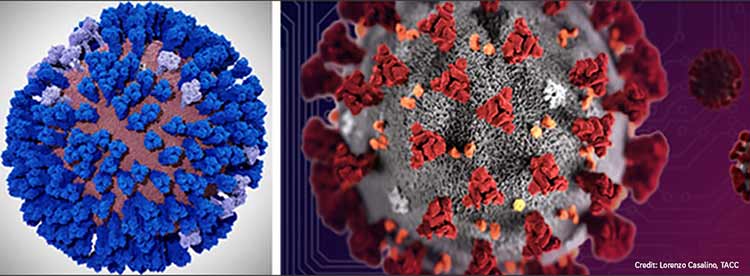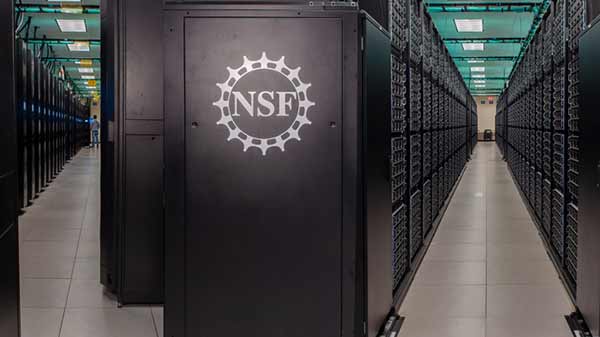
By:
- Jorge Salazar
Published Date
By:
- Jorge Salazar
Share This:

A coronavirus envelope all-atom computer model is being developed by the Amaro Lab of UC San Diego on the NSF-funded Frontera supercomputer of TACC at UT Austin. Biochemist Rommie Amaro hopes to build on her recent success with all-atom influenza virus simulations (left) and apply them to the coronavirus (right). Credit: Lorenzo Casalino (UC San Diego), TACC
Coronavirus Massive Simulations Completed on Supercomputer
UC San Diego biochemist leads new simulations that can help researchers design new drugs and vaccines to combat the coronavirus
Scientists are preparing a massive computer model of the coronavirus that they expect will give insight into how it infects in the body. They've taken the first steps, testing the first parts of the model and optimizing code on the Frontera supercomputer at the University of Texas at Austin. The knowledge gained from the full model can help researchers design new drugs and vaccines to combat the coronavirus.
UC San Diego’s Rommie Amaro is leading efforts to build the first complete all-atom model of the SARS-COV-2 coronavirus envelope, its exterior component.

Rommie Amaro, Professor of Chemistry and Biochemistry, University of California, San Diego.
“If we have a good model for what the outside of the particle looks like and how it behaves, we're going to get a good view of the different components that are involved in molecular recognition,” said Amaro, a professor of chemistry and biochemistry.
Molecular recognition involves how the virus interacts with the angiotensin converting enzyme 2 (ACE2) receptors and possibly other targets within the host cell membrane.
The coronavirus model is anticipated by Amaro to contain roughly 200 million atoms, a daunting undertaking, as the interaction of each atom with one another has to be computed. Her team's workflow takes a hybrid, or integrative modeling approach.
“We're trying to combine data at different resolutions into one cohesive model that can be simulated on leadership-class facilities like Frontera,” Amaro said. “We basically start with the individual components, where their structures have been resolved at atomic or near atomic resolution. We carefully get each of these components up and running and into a state where they are stable. Then we can introduce them into the bigger envelope simulations with neighboring molecules.”
On March 12-13, the Amaro Lab ran molecular dynamics simulations on up to 4,000 nodes, or about 250,000 processing cores, on Frontera at the Texas Advanced Computing Center at the University of Texas at Austin.
Amaro's work with the coronavirus builds on her success with an all-atom simulation of the influenza virus envelope, published in ACS Central Science, in February 2020. She said that the influenza work will have a remarkable number of similarities to what they're now pursuing with the coronavirus.

The NSF-funded Frontera supercomputer of the Texas Advanced Computing Center at UT Austin is ranked #5 fastest in the world and #1 for academic systems, according to the November 2019 Top500 rankings. (Credit: TACC)
“It's a brilliant test of our methods and our abilities to adapt to new data and to get this up and running right off the fly,” Amaro said. “It took us a year or more to build the influenza viral envelope and get it up and running on the national supercomputers. For influenza, we used the Blue Waters supercomputer, which was in some ways the predecessor to Frontera. The work, however, with the coronavirus obviously is proceeding at a much, much faster pace. This is enabled, in part because of the work that we did on Blue Waters earlier.”
According to Amaro, these simulations will provide new insights into the different parts of the coronavirus that are required for infectivity.
“And why we care about that is because if we can understand these different features, scientists have a better chance to design new drugs; to understand how current drugs work and potential drug combinations work. The information that we get from these simulations is multifaceted and multidimensional and will be of use for scientists on the front lines immediately and also in the longer term,” Amaro explained. “Hopefully, the public will understand that there's many different components and facets of science to push forward to understand this virus. These simulations on Frontera are just one of those components, but hopefully an important and a gainful one.”
Click on the following track to listen.
Share This:
You May Also Like
Stay in the Know
Keep up with all the latest from UC San Diego. Subscribe to the newsletter today.


